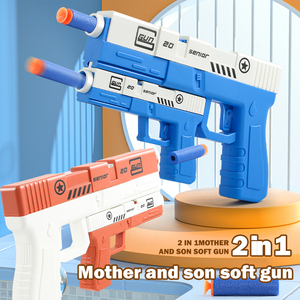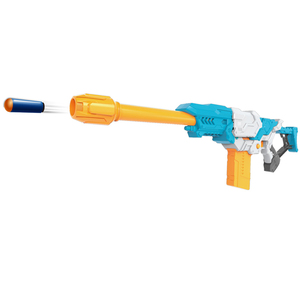(7504 products available)





















































































































































































Toy guns that shoot plastic bullets come in different types, each offering unique features and gameplay experiences. Here are some common types:
Spring-powered toy guns:
These guns use a spring mechanism to load and shoot plastic bullets. The spring is compressed manually by pulling back the gun's mechanism. When the trigger is pulled, the spring releases, propelling the bullet out of the barrel. Spring-powered toy guns are known for their simplicity, reliability, and ease of use. They require no batteries or gas and are often found in lower-priced models. However, they may have a lower rate of fire compared to other types.
Pneumatic toy guns:
Pneumatic toy guns use compressed air to shoot plastic bullets. These guns require the user to pump the handle to build up air pressure inside the chamber. When the trigger is pulled, the increased air pressure sends the bullet flying out of the barrel. Pneumatic toy guns are known for their power and accuracy. They can shoot bullets at a higher velocity than spring-powered guns. They are also more complex and more expensive than spring-powered guns.
Battery-powered toy guns:
Battery-powered toy guns use electric motors to shoot plastic bullets. They can be powered by disposable or rechargeable batteries. There are different types of battery-powered toy guns, including electric pistols, rifles, and machine guns. Every type has its unique firing mechanism, such as electric blowback, gear drive, and motorized feeding. These guns offer semi-automatic and full-automatic firing modes. They can shoot bullets with high speed and accuracy. However, they require regular battery replacement and can be more expensive than other types.
Gel ball blasters:
Gel ball blasters use small, spherical gel balls as ammunition. They are similar to toy guns that shoot plastic bullets but use gel balls instead of bullets. Gel ball blasters come in different types, such as spring-powered, electric, and gas blowback. Spring-powered gel ball blasters use a spring mechanism to load and shoot gel balls. Electric gel ball blasters use electric motors for firing. Gas blowback gel ball blasters use gas for shooting and provide a more realistic shooting experience. Both electric and gas gel ball blasters offer higher rates of fire and better accuracy than spring-powered ones. They can also be more expensive and require more maintenance.
When selecting a toy gun for plastic bullet shooting, consider the child's age, interests, and the available safety features. Also, think about the gun's design, mechanism, and the type of plastic bullets it uses. The environment where the child will play with the toy gun is essential. More importantly, evaluate the gun's quality and durability to ensure it can withstand rough handling by kids.
The first thing to do when choosing a toy gun is to ascertain that it meets the child's age and developmental stage. Some toy guns are complicated and have realistic features that can confuse a child. At the same time, others have simple mechanisms and designs that are easy to operate. The material used to make the toy gun is also important. It should be non-toxic and free from harmful chemicals that can endanger a child's health.
Parental supervision is necessary when kids are playing with toy guns. Therefore, choose a model that is easy to assemble and disassemble. This will ensure the parent can load and unload the gun's magazine with ease. Also, choose a model with clear instructions on how to use it safely. The instructions should also include the age limit and the safety precautions to take. Since young children may not understand the dangers of pointing a gun at someone, choose a model with a storage case or a carrying pouch. This way, the toy gun can be stored safely when not in use.
The mechanism of a toy gun largely determines how it will perform. Therefore, choose one with a spring-action mechanism since it is simpler and more reliable than electric and gas-powered models. A spring-action toy gun will also require less maintenance. Consider the type of plastic bullets the toy gun uses. Ensure they are of the appropriate size for the child and compatible with the gun. Look for toy guns with biodegradable and impact-absorbing plastic bullets. Also, consider whether the gun can fire the bullets accurately over a long distance. This is important for target practice.
The material used to make the toy gun should also be durable, whether metal or plastic. It should be able to withstand rough play without breaking. Moreover, choose a toy gun with realistic construction and details, as this will make the shooting game interesting. The toy gun should also have safety features, such as a trigger lock and a manual safety switch. These will prevent accidental firing. Finally, consider the manufacturer's reputation and the reviews of other customers before purchasing a toy gun that shoots plastic bullets.
Toy guns that shoot plastic bullets come in different designs that affect their functions and features. The primary function of these toy guns is to provide kids with a playful and safe shooting experience. The guns are designed to shoot plastic bullets, which are soft and lightweight, reducing the risk of injury during play. Additionally, the plastic bullets are easy to load into the gun, ensuring that kids can have uninterrupted fun. Another critical function of these toy guns is to enhance kids' imaginative play. With designs that mimic real guns, these toys allow kids to create scenarios that involve shooting, targeting, and hunting.
One of the main features of toy guns that shoot plastic bullets is their safety. The plastic bullets are much safer than the metal or hard glass ones, minimizing the risk of injury during play. Additionally, many of these toy guns come with safety locks and mechanisms that prevent accidental discharge, ensuring that kids can play safely. Another essential feature of these toy guns is their ease of use. The guns are lightweight and have comfortable grips, making it easy for kids to handle them. Moreover, loading the plastic bullets into the gun is a simple process, ensuring that kids can quickly get back to playing after reloading.
The design of toy guns that shoot plastic bullets is based on both aesthetic and functional considerations. From an aesthetic perspective, these toy guns come in designs that resemble real guns. This makes them appealing to kids who enjoy playing with guns. The realistic designs also include features such as sound effects and recoil action, further enhancing the play experience. Functionally, the toy guns are designed to be easy to use. They are lightweight and have comfortable grips, making them easy to handle. Additionally, many of these toy guns come with adjustable sights and other features that enhance accuracy and precision during play.
Toy guns that shoot plastic bullets are generally considered safer than real guns, but they still pose some risks. Here are the safety features and considerations that make them safer:
Design and Construction
These toy guns are often designed with bright colors and unusual shapes that clearly distinguish them from real firearms. Many toy guns incorporate safety features such as non-removable, brightly colored muzzles, locks that prevent firing mechanisms, and more. The design should also eliminate parts that can be easily detached and swallowed by young children.
Materials Used
The materials used in making toy guns should be non-toxic and should not contain harmful substances like lead or phthalates. They should also be sturdy enough to withstand normal play without breaking into small, sharp pieces.
Age Appropriateness
Manufacturers usually indicate appropriate age ranges for their products. Toy guns for younger children are usually made with safer materials and designs that are less realistic, and they are also produced without small parts that can be choking hazards. Also, children of different ages have different maturity levels and capabilities when it comes to understanding the implications of using a gun.
Compliance with Safety Standards
Manufacturers of toy guns are required to comply with safety standards set by organizations like the American Society for Testing and Materials (ASTM) or the European Committee for Standardization (CEN). These safety standards are developed to ensure the toys are safe for children to use. The standards cover a wide range of safety issues, including mechanical, physical, chemical, and electrical hazards.
Toy guns that shoot plastic bullets can vary in quality depending on the manufacturer, brand, and specific model. Here are some factors to consider when evaluating the quality of a toy gun:
Durability
Good-quality toy guns are made from durable materials that can endure rough play without breaking or falling apart. They should be well-constructed with solid joints and seams to prevent pieces from becoming loose or detachable.
Accuracy of Shooting
While safety is the main concern, some children might want their toy guns to have a certain level of accuracy when shooting plastic bullets. This can contribute to better play experiences. However, it is important to strike a balance between accuracy and safety to prevent any potential harm or injury.
Brand Reputation
Going for toy guns from reputable brands with positive reviews can increase the chances of getting a quality product. Reputable brands usually adhere to strict safety and quality standards and their products are often subjected to thorough testing before being released to the market.
What age group is suitable for toy guns that shoot plastic bullets?
Generally, toy guns are designed for children aged over 8 years. However, depending on the brand and model, the age range might differ. Always check the manufacturer recommendations and industry regulations for child safety.
What measures can be taken to ensure the safe use of toy guns that shoot plastic bullets?
To enhance the safety of toy guns, implement measures such as shooting only at designated targets, using eye protection, and never pointing at anyone, even in play. Follow the manufacturer's instructions for proper use and handle all toys, including guns, with responsibility and care.
How can someone distinguish between a safe toy gun and one that might be dangerous?
Look for toy guns made from durable, non-toxic materials with safety features like lower-powered projectile guns. Ensure it has the ASTM F963 label and complies with toy gun safety standards. Keep plastic bullet toy guns out of the reach of young children and supervise their play.
What should someone do if a plastic bullet from a toy gun hits someone?
If a plastic bullet from a toy gun accidentally strikes someone, immediately assess their condition and offer assistance. If there is an injury, it is advisable to seek medical attention and report the incident to the authorities. Apologize and ensure that such accidents do not happen again by taking the necessary safety precautions when handling toy guns.